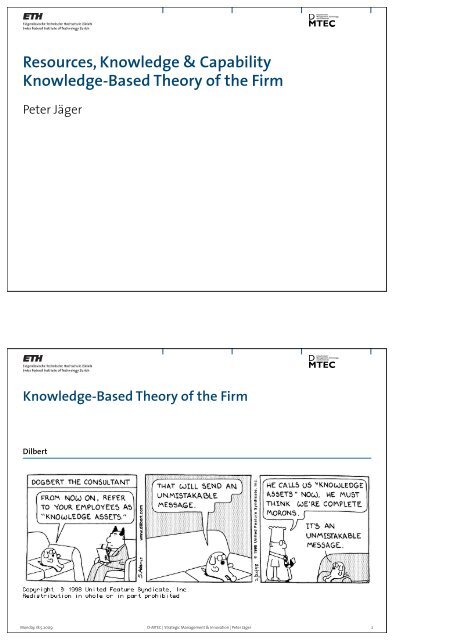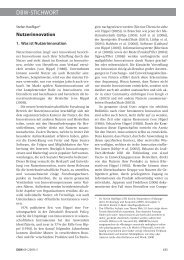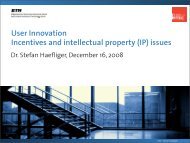Knowledge of the Firm - SMI
Knowledge of the Firm - SMI
Knowledge of the Firm - SMI
You also want an ePaper? Increase the reach of your titles
YUMPU automatically turns print PDFs into web optimized ePapers that Google loves.
Resources, <strong>Knowledge</strong> & Capability<br />
<strong>Knowledge</strong>-Based Theory <strong>of</strong> <strong>the</strong> <strong>Firm</strong><br />
Peter Jäger<br />
<strong>Knowledge</strong>-Based Theory <strong>of</strong> <strong>the</strong> <strong>Firm</strong><br />
Dilbert<br />
Monday, 18.5.2009<br />
D-MTEC | Strategic Management & Innovation | Peter Jäger<br />
2
Course Overview<br />
Introduction<br />
Industry<br />
Dynamics II<br />
Guest Lecture<br />
UBS<br />
<strong>Knowledge</strong><br />
Based Theory<br />
Industry<br />
Dynamics I<br />
Guest Lecture<br />
PwC<br />
Resource<br />
Based Theory<br />
9.3.2009<br />
16.3.2009<br />
30.3.2009<br />
6.4.2009<br />
27.4.2009<br />
4.5.2009<br />
18.5.2009<br />
Cola Wars Linux &<br />
RedHat<br />
Student case presentations<br />
Swissair<br />
Swatch<br />
McKinsey<br />
Monday, 18.5.2009<br />
D-MTEC | Strategic Management & Innovation | Peter Jäger<br />
3<br />
Competitive Strategy<br />
Competitive strategy is concerned with “Creating and<br />
maintaining a competitive advantage in each and every<br />
area <strong>of</strong> business”<br />
Michael Porter (1980)<br />
Competitive strategy is concerned<br />
with <strong>the</strong> firm’s actions that make<br />
<strong>the</strong> firm outperform its competitors<br />
Monday, 18.5.2009<br />
D-MTEC | Strategic Management & Innovation | Peter Jäger<br />
4
<strong>Knowledge</strong>-Based Theory <strong>of</strong> <strong>the</strong> <strong>Firm</strong><br />
Competitive advantage results<br />
from <strong>the</strong> ability <strong>of</strong> <strong>the</strong> firm to<br />
find knowledge distant to <strong>the</strong><br />
own firm<br />
Levinthal & March (1993)<br />
Monday, 18.5.2009<br />
D-MTEC | Strategic Management & Innovation | Peter Jäger<br />
5<br />
<strong>Knowledge</strong>-Based Theory <strong>of</strong> <strong>the</strong> <strong>Firm</strong><br />
Objectives<br />
<br />
<br />
<br />
<br />
How does knowledge impact on <strong>the</strong> economic performance and <strong>the</strong> sustained competitive<br />
advantage <strong>of</strong> a firm<br />
Understanding <strong>the</strong> core knowledge processes <strong>of</strong> a firm<br />
What are <strong>the</strong> means to capture & locate knowledge within a company<br />
How can knowledge be shared and exchanged efficiently<br />
Under what circumstances is new knowledge generated<br />
Which capabilities do firms need to manage <strong>the</strong> knowledge processes<br />
How can <strong>the</strong> strategic investments in knowledge be protected for future returns appropriation<br />
What means for protection do exist<br />
What are <strong>the</strong> limitations <strong>of</strong> those protective mechanisms<br />
Monday, 18.5.2009<br />
D-MTEC | Strategic Management & Innovation | Peter Jäger<br />
6
Contents<br />
<strong>Knowledge</strong> <strong>of</strong> <strong>the</strong> <strong>Firm</strong><br />
Combinative Capabilities<br />
Integrative Capabilities<br />
Protective Capabilities<br />
Biotechnology Example<br />
Monday, 18.5.2009<br />
D-MTEC | Strategic Management & Innovation | Peter Jäger<br />
7<br />
<strong>Knowledge</strong> <strong>of</strong> <strong>the</strong> <strong>Firm</strong><br />
A view <strong>of</strong> <strong>the</strong> firm as repositories and processes <strong>of</strong> knowledge<br />
Core questions asked<br />
<br />
<br />
<br />
<br />
<br />
What are organizational processes related to knowledge?<br />
What is <strong>the</strong> endowment <strong>of</strong> knowledge repositories <strong>of</strong> <strong>the</strong> firm<br />
and why do firms differ?<br />
What is <strong>the</strong> relationship between a firm’s knowledge repositories,<br />
processes and its performance?<br />
What are mechanisms to prevent knowledge leakage?<br />
On which <strong>of</strong> <strong>the</strong> firm’s existing and new knowledge would entry<br />
into new market and industries be based?<br />
Nonaka (1991); Kogut & Zander (1992); von Krogh, Roos & Slocum (1996); Tsoukas (1996); Grant (1996)<br />
Monday, 18.5.2009<br />
D-MTEC | Strategic Management & Innovation | Peter Jäger<br />
8
<strong>Knowledge</strong> <strong>of</strong> <strong>the</strong> <strong>Firm</strong><br />
A view <strong>of</strong> <strong>the</strong> firm as repositories and processes <strong>of</strong> knowledge<br />
Core questions asked<br />
<br />
<br />
<br />
What are firm boundaries?<br />
What are options for managing knolwedge in <strong>the</strong> firm, and how<br />
do firms differ int heir knowledge management?<br />
What is <strong>the</strong> relationship between knowledge management and<br />
performance?<br />
Nonaka (1991); Kogut & Zander (1992); von Krogh, Roos & Slocum (1996); Tsoukas (1996); Grant (1996)<br />
Monday, 18.5.2009<br />
D-MTEC | Strategic Management & Innovation | Peter Jäger<br />
9<br />
<strong>Knowledge</strong> <strong>of</strong> <strong>the</strong> <strong>Firm</strong><br />
Defining <strong>the</strong> <strong>Knowledge</strong> Domain – Dimensions<br />
Relevant Data<br />
Data are <strong>the</strong> basic building<br />
blocks for information, i.e.<br />
Sales-, industry-, consumer-,<br />
and financial data<br />
Relevant Information<br />
Information is data that<br />
have been arranged into<br />
meaningful patterns<br />
It might be given in<br />
sentences, policies models,<br />
or tools<br />
Relevant <strong>Knowledge</strong><br />
<strong>Knowledge</strong> gives <strong>the</strong><br />
potential to act and also<br />
gives <strong>the</strong> capacity to<br />
transform data and<br />
information into ideas and<br />
decisions<br />
It can be ei<strong>the</strong>r explicit or<br />
tacit in nature<br />
and individual or social<br />
Monday, 18.5.2009<br />
D-MTEC | Strategic Management & Innovation | Peter Jäger<br />
10
<strong>Knowledge</strong> <strong>of</strong> <strong>the</strong> <strong>Firm</strong><br />
E<br />
Example<br />
“I think with a deep sadness about our civilization.<br />
While we measure <strong>the</strong> temperature in <strong>the</strong> Venus<br />
atmosphere, we ignore <strong>the</strong> temperature <strong>of</strong> our soufflés”<br />
Nicholas Kurti (1970)<br />
Hervas-Oliver, Albors & De-Miguel-Molina (2009)<br />
Monday, 18.5.2009<br />
D-MTEC | Strategic Management & Innovation | Peter Jäger<br />
11<br />
<strong>Knowledge</strong> <strong>of</strong> <strong>the</strong> <strong>Firm</strong><br />
E<br />
Example<br />
“Science produces knowledge and knowledge<br />
is what makes us different from animals.<br />
So science is important because we are not<br />
animals.”<br />
Hervé This<br />
Monday, 18.5.2009<br />
D-MTEC | Strategic Management & Innovation | Peter Jäger<br />
X
<strong>Knowledge</strong> <strong>of</strong> <strong>the</strong> <strong>Firm</strong><br />
E<br />
Example<br />
Science in <strong>the</strong> kitchen – New tendencies in culinary services innovation<br />
100%<br />
80%<br />
60%<br />
Explicit<br />
40%<br />
20%<br />
0%<br />
17th 18th 19th 20th 21st<br />
Culinary<br />
Origins<br />
Manuals<br />
& Receipes<br />
Trades Chefs<br />
Restaurants<br />
Cooking Schools<br />
Diffusion<br />
<strong>of</strong> Cooking<br />
Tacit<br />
Science<br />
Emergence <strong>of</strong><br />
Cooking as business<br />
Gastrovac<br />
Hervas-Oliver, Albors & De-Miguel-Molina (2009)<br />
Monday, 18.5.2009<br />
D-MTEC | Strategic Management & Innovation | Peter Jäger<br />
12<br />
<strong>Knowledge</strong> <strong>of</strong> <strong>the</strong> <strong>Firm</strong><br />
E<br />
Example<br />
Science in <strong>the</strong> kitchen – New tendencies in culinary services innovation<br />
100%<br />
80%<br />
60%<br />
Symbolic<br />
Explicit<br />
40%<br />
20%<br />
Analytical<br />
Tacit<br />
0%<br />
Syn<strong>the</strong>tic<br />
17th 18th 19th 20th 21st<br />
Gastrovac<br />
Culinary<br />
Origins<br />
Manuals<br />
& Receipes<br />
Trades Chefs<br />
Restaurants<br />
Cooking Schools<br />
Diffusion<br />
<strong>of</strong> Cooking<br />
Science<br />
Emergence <strong>of</strong><br />
Cooking as business<br />
Hervas-Oliver, Albors & De-Miguel-Molina (2009)<br />
Monday, 18.5.2009<br />
D-MTEC | Strategic Management & Innovation | Peter Jäger<br />
X
<strong>Knowledge</strong> <strong>of</strong> <strong>the</strong> <strong>Firm</strong><br />
E<br />
Example<br />
Science in <strong>the</strong> kitchen – New tendencies in culinary services innovation<br />
<strong>Knowledge</strong> Phase<br />
Analytical<br />
Syn<strong>the</strong>tical<br />
Symbolic<br />
Exploration<br />
Vacuum Impregnation<br />
technology<br />
available (2000)<br />
R&D Science<br />
exploration 2002<br />
Javier Andres &<br />
Sergio Torres<br />
Work toge<strong>the</strong>r<br />
with Scientists<br />
Brainstorming 2001-02<br />
Demand identified for<br />
“al dente vegetables”<br />
Product Concept<br />
October 2001<br />
Examination<br />
Exploitation<br />
<strong>Knowledge</strong><br />
Transmission<br />
Explicit<br />
Tacit<br />
Hervas-Oliver, Albors & De-Miguel-Molina (2009)<br />
Monday, 18.5.2009<br />
D-MTEC | Strategic Management & Innovation | Peter Jäger<br />
13<br />
<strong>Knowledge</strong> <strong>of</strong> <strong>the</strong> <strong>Firm</strong><br />
Model <strong>of</strong> company development<br />
Process<br />
focus<br />
Content<br />
focus<br />
1.<br />
2.<br />
Focus on existing<br />
knowledge<br />
3.<br />
1. Capturing<br />
and Locating 2. Sharing 3. Creating<br />
Focus on new<br />
knowledge<br />
Monday, 18.5.2009<br />
D-MTEC | Strategic Management & Innovation | Peter Jäger<br />
14
<strong>Knowledge</strong> <strong>of</strong> <strong>the</strong> <strong>Firm</strong><br />
Core<br />
knowledge<br />
process to<br />
achieve<br />
business<br />
objectives<br />
Capturing &<br />
Locating<br />
Sharing<br />
Locating and capturing existing knowledge<br />
Transferring or exchanging explicit and tacit<br />
knowledge<br />
Creating<br />
Generating new explicit and tacit<br />
knowledge by individual or groups<br />
Monday, 18.5.2009<br />
D-MTEC | Strategic Management & Innovation | Peter Jäger<br />
15<br />
<strong>Knowledge</strong> <strong>of</strong> <strong>the</strong> <strong>Firm</strong><br />
Core<br />
knowledge<br />
process to<br />
achieve<br />
business<br />
objectives<br />
Capturing &<br />
Locating<br />
Sharing<br />
Developing a “knowledge map”<br />
By developing a <strong>Knowledge</strong> Map, i.e. an<br />
actual map, yellow pages, or a smartly<br />
structured database <strong>the</strong> company can create<br />
an inventory <strong>of</strong> existing knowledge<br />
Creating<br />
Making tacit knowledge accessible<br />
Tacit knowledge can be made accessible by<br />
ensuring its identification<br />
Monday, 18.5.2009<br />
D-MTEC | Strategic Management & Innovation | Peter Jäger<br />
16
<strong>Knowledge</strong> <strong>of</strong> <strong>the</strong> <strong>Firm</strong><br />
B<br />
Backup<br />
Crowdcasting<br />
Who wants to be a millionaire?<br />
getting <strong>the</strong> correct answer when drawing <strong>the</strong> joker …<br />
65% calling a friend<br />
91% ask <strong>the</strong> studio<br />
-> wisdom <strong>of</strong> <strong>the</strong> crowd<br />
James Surowiecki<br />
Monday, 18.5.2009<br />
D-MTEC | Strategic Management & Innovation | Peter Jäger<br />
X<br />
<strong>Knowledge</strong> <strong>of</strong> <strong>the</strong> <strong>Firm</strong><br />
Core<br />
knowledge<br />
process to<br />
achieve<br />
business<br />
objectives<br />
Capturing &<br />
Locating<br />
Sharing<br />
Creating<br />
One-Way Sharing<br />
Transfer explicit knowledge from one person,<br />
group, department, unit, or company to an<br />
o<strong>the</strong>r<br />
Two-Way Sharing<br />
Exchanging explicit and tacit knowledge<br />
within a group <strong>of</strong> people through “face<br />
to face” interaction and intensive<br />
dialogue<br />
Monday, 18.5.2009<br />
D-MTEC | Strategic Management & Innovation | Peter Jäger<br />
17
<strong>Knowledge</strong> <strong>of</strong> <strong>the</strong> <strong>Firm</strong><br />
Core<br />
knowledge<br />
process to<br />
achieve<br />
business<br />
objectives<br />
Capturing &<br />
Locating<br />
Sharing<br />
Explicit<br />
(10-20%)<br />
Tacit<br />
(80-90%)<br />
Eli Lilly<br />
Model<br />
Explicit<br />
(25-35%)<br />
Creating<br />
Tacit<br />
(65-75%)<br />
Monday, 18.5.2009<br />
D-MTEC | Strategic Management & Innovation | Peter Jäger<br />
18<br />
Calculation Broker Value<br />
B<br />
Backup<br />
Annual Pr<strong>of</strong>it Contribution [USD t]<br />
100<br />
50<br />
0<br />
-50<br />
-100<br />
5 25 34 44 52 56 60 63 65 67<br />
-55<br />
0 1 2 3 4 5 6 7 8 9 10<br />
Broker Tenure [yrs]<br />
Broker NPV [USD]<br />
35.000<br />
+155%<br />
23.333<br />
11.667<br />
0<br />
33<br />
13<br />
80% 90%<br />
Retention Rate<br />
Reichheld (1996)<br />
Monday, 18.5.2009<br />
D-MTEC | Strategic Management & Innovation | Peter Jäger<br />
X
<strong>Knowledge</strong> <strong>of</strong> <strong>the</strong> <strong>Firm</strong><br />
Core Definitions<br />
<br />
<br />
<br />
<br />
<strong>Firm</strong>s outperform markets and o<strong>the</strong>r firms in creating and<br />
transferring knowledge<br />
The recurrent patterns in creating, transferring, or o<strong>the</strong>rwise<br />
“managing” knowledge are referred to as capabilities<br />
Technology and knowledge is <strong>of</strong>ten costly to replicate, whe<strong>the</strong>r<br />
<strong>the</strong> replication is desired by <strong>the</strong> firm or occurs by imitation and<br />
spillover<br />
The codification <strong>of</strong> knowledge to make transfer less costly and<br />
more speedy, enhances <strong>the</strong> risk <strong>of</strong> imitation and spillover<br />
Monday, 18.5.2009<br />
D-MTEC | Strategic Management & Innovation | Peter Jäger<br />
19<br />
<strong>Knowledge</strong> <strong>of</strong> <strong>the</strong> <strong>Firm</strong><br />
Combinative capabilities<br />
Value<br />
Integrative capabilities<br />
Cost<br />
Economic<br />
performance<br />
Protective capabilities<br />
Returns appropriation<br />
Monday, 18.5.2009<br />
D-MTEC | Strategic Management & Innovation | Peter Jäger<br />
20
Contents<br />
<strong>Knowledge</strong> <strong>of</strong> <strong>the</strong> <strong>Firm</strong><br />
Combinative Capabilities<br />
Integrative Capabilities<br />
Protective Capabilities<br />
Biotechnology Example<br />
Monday, 18.5.2009<br />
D-MTEC | Strategic Management & Innovation | Peter Jäger<br />
21<br />
Combinative Capabilities<br />
Growth <strong>of</strong> knowledge <strong>of</strong> <strong>the</strong> firm<br />
Market<br />
opportunities<br />
Information<br />
e.g. costs<br />
<strong>Knowledge</strong><br />
e.g. divisionalize<br />
Combinative<br />
capabilities<br />
Organizing &<br />
technological<br />
opportunities<br />
MO1<br />
MO2<br />
MO3<br />
MO4<br />
….<br />
MOn<br />
Internal learning<br />
External learning<br />
Kogut & Zander (1992)<br />
Monday, 18.5.2009<br />
D-MTEC | Strategic Management & Innovation | Peter Jäger<br />
22
Combinative Capabilities<br />
Growth <strong>of</strong> knowledge <strong>of</strong> <strong>the</strong> firm<br />
Market<br />
opportunities<br />
Information<br />
e.g. costs<br />
<strong>Knowledge</strong><br />
e.g. divisionalize<br />
Combinative<br />
capabilities<br />
Organizing &<br />
technological<br />
opportunities<br />
MO1<br />
MO2<br />
MO3<br />
MO4<br />
….<br />
MOn<br />
Internal learning<br />
External learning<br />
Kogut & Zander (1992)<br />
Monday, 18.5.2009<br />
D-MTEC | Strategic Management & Innovation | Peter Jäger<br />
23<br />
Combinative Capabilities<br />
B<br />
Backup<br />
<br />
<br />
A firm’s knowledge and information is related to various functions and tasks<br />
Within <strong>the</strong> firm, functional knowledge and information is nested in higher order organizing<br />
principles. These secure:<br />
Communication between functions<br />
Integration <strong>of</strong> knowledge within functions<br />
Integration knowledge across functions<br />
The codification <strong>of</strong> individual knowledge<br />
The sharing <strong>of</strong> tacit knowledge between individuals and groups<br />
Monday, 18.5.2009<br />
D-MTEC | Strategic Management & Innovation | Peter Jäger<br />
X
Combinative Capabilities<br />
Growth <strong>of</strong> knowledge <strong>of</strong> <strong>the</strong> firm<br />
Market<br />
opportunities<br />
Information<br />
e.g. costs<br />
<strong>Knowledge</strong><br />
e.g. divisionalize<br />
Combinative<br />
capabilities<br />
Organizing &<br />
technological<br />
opportunities<br />
MO1<br />
MO2<br />
MO3<br />
MO4<br />
….<br />
MOn<br />
Internal learning<br />
External learning<br />
Kogut & Zander (1992)<br />
Monday, 18.5.2009<br />
D-MTEC | Strategic Management & Innovation | Peter Jäger<br />
24<br />
Combinative Capabilities<br />
B<br />
Backup<br />
The paradox <strong>of</strong> replication<br />
<br />
<br />
<br />
<br />
<br />
The growth <strong>of</strong> <strong>the</strong> firm hinges on making technical knowledge explicit, understood by a large<br />
number <strong>of</strong> users<br />
The speed <strong>of</strong> replication <strong>of</strong> technical knowledge impacts <strong>the</strong> rate <strong>of</strong> growth <strong>of</strong> <strong>the</strong> firm<br />
Whereas <strong>the</strong> advantages <strong>of</strong> reducing cost <strong>of</strong> intra- and inter-firm technology transfer encourage<br />
codification <strong>of</strong> knowledge (making it explicit), such codification creates an incentive to imitate<br />
Technology transfer: Adapting <strong>the</strong> technology to <strong>the</strong> least capable user<br />
Imitation: Adapting <strong>the</strong> technology to <strong>the</strong> most capable competitors<br />
Monday, 18.5.2009<br />
D-MTEC | Strategic Management & Innovation | Peter Jäger<br />
X
Combinative Capabilities<br />
Codification <strong>of</strong> knowledge (explicit) enables growth but lowers <strong>the</strong> barriers to imitation<br />
<strong>Firm</strong> B<br />
Unique historical conditions<br />
Causal ambiguity<br />
Social complexity<br />
Intellectual property<br />
Unchanged<br />
Lowered<br />
Lowered<br />
Unchanged<br />
Economic performance<br />
Monday, 18.5.2009<br />
D-MTEC | Strategic Management & Innovation | Peter Jäger<br />
25<br />
Imitation<br />
B<br />
Backup<br />
Unique historical conditions<br />
<br />
<br />
The low-cost acquisition or development <strong>of</strong> a firm’s<br />
resource depended on a unique historical condition<br />
As a source <strong>of</strong> imperfect imitability, a unique historical<br />
condition can<br />
Give <strong>the</strong> firm a first-mover advantage<br />
Provide <strong>the</strong> firm with competitive advantages in<br />
later time periods, based on resources acquired or<br />
developed in earlier periods<br />
Monday, 18.5.2009<br />
D-MTEC | Strategic Management & Innovation | Peter Jäger<br />
X
Imitation<br />
B<br />
Backup<br />
Causal ambiguity<br />
<br />
<br />
<br />
The resources <strong>of</strong> a firm may be costly to imitate because for <strong>the</strong> imitating firm, <strong>the</strong> relationship<br />
between resources controlled by <strong>the</strong> firm and its competitive advantage may be causally<br />
ambiguous<br />
If managers <strong>of</strong> firm B understand <strong>the</strong> relationship between resources and competitive<br />
advantage, it is likely that, with time, this understanding will be shared by managers <strong>of</strong> <strong>the</strong><br />
imitating firm A<br />
Managers in firm B, however may not completely understand this relationship because:<br />
Resources that generate competitive advantage are taken for granted<br />
The combinations <strong>of</strong> resources that generate competitive advantage are difficult to evaluate<br />
(thousands <strong>of</strong> smaller resources taken toge<strong>the</strong>r generate <strong>the</strong> competitive advantage)<br />
Monday, 18.5.2009<br />
D-MTEC | Strategic Management & Innovation | Peter Jäger<br />
X<br />
Imitation<br />
B<br />
Backup<br />
Social complexity<br />
<br />
<br />
<br />
<br />
Resources may be costly to imitate because <strong>the</strong>y are socially complex phenomena, beyond <strong>the</strong><br />
ability <strong>of</strong> firms to systematically manage and influence<br />
Typically socially complex resources include<br />
Interpersonal relations among managers<br />
A firm‘s culture<br />
A firm‘s reputation among suppliers and customers<br />
Social complexity <strong>of</strong> resources does require causal ambiguity and vice versa<br />
Non-valuable, socially complex resources can be a source <strong>of</strong> significant, sustainable competitive<br />
disadvantage (Leonard, 1998)<br />
Monday, 18.5.2009<br />
D-MTEC | Strategic Management & Innovation | Peter Jäger<br />
X
Imitation<br />
B<br />
Backup<br />
Intellectual property<br />
<br />
<br />
Although a physical technology may not be costly to imitate<br />
(e.g. through reverse engineering), <strong>the</strong> resources surrounding<br />
<strong>the</strong> implementation, usage, and development <strong>of</strong> this<br />
technology may be socially complex and even causally<br />
ambiguous<br />
Intellectual property protected through various mechanisms<br />
can be costly to acquire and/or imitate for o<strong>the</strong>r firms<br />
Monday, 18.5.2009<br />
D-MTEC | Strategic Management & Innovation | Peter Jäger<br />
X<br />
Combinative Capabilities<br />
B<br />
Backup<br />
Combinative capability<br />
<br />
<br />
<br />
<br />
The capability <strong>of</strong> <strong>the</strong> firm to integrate learning from outside and inside its boundaries<br />
The capability <strong>of</strong> <strong>the</strong> firm to exploits its knowledge and <strong>the</strong> unexplored potential <strong>of</strong> <strong>the</strong><br />
technology<br />
The unexplored potential <strong>of</strong> technology both refers to <strong>the</strong> opportunities within technical<br />
limitations (S-curve) and opportunities to apply technologies to new uses<br />
<strong>Knowledge</strong> advances by recombination because a firm’s capabilities cannot be separated from<br />
how it is currently organized<br />
Monday, 18.5.2009<br />
D-MTEC | Strategic Management & Innovation | Peter Jäger<br />
X
Combinative Capabilities<br />
“To produce o<strong>the</strong>r things, or <strong>the</strong> same things by different<br />
method, means to combine <strong>the</strong>se materials and forces<br />
differently.<br />
Development … is <strong>the</strong>n defined by <strong>the</strong> carrying out <strong>of</strong> new<br />
combinations.”<br />
Joseph Schumpeter (1934)<br />
Monday, 18.5.2009<br />
D-MTEC | Strategic Management & Innovation | Peter Jäger<br />
26<br />
Combinative Capabilities<br />
Growth <strong>of</strong> knowledge <strong>of</strong> <strong>the</strong> firm<br />
Market<br />
opportunities<br />
Information<br />
e.g. costs<br />
<strong>Knowledge</strong><br />
e.g. divisionalize<br />
Combinative<br />
capabilities<br />
Organizing &<br />
technological<br />
opportunities<br />
MO1<br />
MO2<br />
MO3<br />
MO4<br />
….<br />
MOn<br />
Internal learning<br />
External learning<br />
Kogut & Zander (1992)<br />
Monday, 18.5.2009<br />
D-MTEC | Strategic Management & Innovation | Peter Jäger<br />
27
Combinative Capabilities<br />
B<br />
Backup<br />
<br />
<br />
The firm needs to organize so that knowledge from external and internal sources can be used in<br />
developing products and services to meet market opportunities<br />
The firm’s competitive advantage, and economic performance hinges on <strong>the</strong> nature <strong>of</strong> its<br />
combinative capabilities, replication <strong>of</strong> technical knowledge, and imitation <strong>of</strong> knowledge by<br />
competitors<br />
Monday, 18.5.2009<br />
D-MTEC | Strategic Management & Innovation | Peter Jäger<br />
X<br />
Contents<br />
<strong>Knowledge</strong> <strong>of</strong> <strong>the</strong> <strong>Firm</strong><br />
Combinative Capabilities<br />
Integrative Capabilities<br />
Protective Capabilities<br />
Biotechnology Example<br />
Monday, 18.5.2009<br />
D-MTEC | Strategic Management & Innovation | Peter Jäger<br />
28
Integrative Capabilities<br />
Principles about knowledge and <strong>the</strong> firm<br />
Transferability<br />
Explicit knowledge is revealed by its communication, tacit<br />
knowledge is revealed through its application. Transfer <strong>of</strong><br />
tacit knowledge is slow, costly, and uncertain<br />
Aggregation<br />
The efficiency with which knowledge can be transferred,<br />
depends on its aggregation<br />
Appropriability<br />
The ability <strong>of</strong> <strong>the</strong> owner <strong>of</strong> knowledge to receive a return<br />
equal to <strong>the</strong> value created by <strong>the</strong> knowledge<br />
Monday, 18.5.2009<br />
D-MTEC | Strategic Management & Innovation | Peter Jäger<br />
Source: Grant (1996)<br />
29<br />
Integrative Capabilities<br />
Principles about knowledge and <strong>the</strong> firm<br />
Specialization<br />
Because humans have limited capacity to acquire, store,<br />
and process knowledge, efficient production <strong>of</strong> knowledge<br />
requires specialization<br />
Requirements <strong>of</strong> production<br />
<strong>Knowledge</strong> is <strong>the</strong> most important input-factor to<br />
production<br />
Monday, 18.5.2009<br />
D-MTEC | Strategic Management & Innovation | Peter Jäger<br />
Source: Grant (1996)<br />
30
Integrative Capabilities<br />
“… production requires <strong>the</strong> coordinated efforts <strong>of</strong> individual<br />
specialists who possess many different types <strong>of</strong> knowledge”<br />
Robert M. Grant<br />
Monday, 18.5.2009<br />
D-MTEC | Strategic Management & Innovation | Peter Jäger<br />
31<br />
Integrative Capabilities<br />
<br />
<br />
Transferring knowledge is not an efficient<br />
approach to integrating knowledge<br />
If production requires <strong>the</strong> integration <strong>of</strong><br />
specialists’ knowledge, efficiency is achieved<br />
by effective integration while minimizing<br />
knowledge transfer through cross-learning<br />
by organizational members<br />
Monday, 18.5.2009<br />
D-MTEC | Strategic Management & Innovation | Peter Jäger<br />
32
Integrative Capabilities<br />
How to efficiently integrate knowledge?<br />
<br />
<br />
A generic production process<br />
Efficient use <strong>of</strong> knowledge inputs requires application <strong>of</strong> specialized knowledge to each<br />
transformation step 1 to n<br />
K1 K2 K3 K4 K5 K6 K7 Kn<br />
1 2 3 4 5 6 7 n<br />
…<br />
<strong>Knowledge</strong><br />
Production<br />
(transformation steps)<br />
Monday, 18.5.2009<br />
D-MTEC | Strategic Management & Innovation | Peter Jäger<br />
33<br />
Integrative Capabilities<br />
Mechanisms for integrating knowledge in <strong>the</strong> firm<br />
Integration<br />
mechanisms<br />
Rules and directives<br />
Sequencing<br />
Routines<br />
Group problem solving and decision<br />
making<br />
Monday, 18.5.2009<br />
D-MTEC | Strategic Management & Innovation | Peter Jäger<br />
34
Integrative Capabilities<br />
Mechanisms for integrating knowledge in <strong>the</strong> firm<br />
Integration<br />
mechanisms<br />
Rules and directives<br />
Sequencing<br />
Routines<br />
Group problem solving and decision<br />
making<br />
Monday, 18.5.2009<br />
D-MTEC | Strategic Management & Innovation | Peter Jäger<br />
35<br />
Integrative Capabilities<br />
Rules and directives<br />
<br />
<br />
<br />
Plans, schedules, forecasts, rules, policies, procedures, standardized information and<br />
communication systems<br />
Regulates application <strong>of</strong> knowledge on transformation steps 1 to n<br />
Regulates <strong>the</strong> needed interaction between those who hold specialized knowledge<br />
K1 K2 K3 K4 K5 K6 K7 Kn<br />
1 2 3 4 5 6 7 n<br />
…<br />
<strong>Knowledge</strong><br />
Production<br />
(transformation steps)<br />
Rules and directives regulating<br />
communication between experts<br />
Monday, 18.5.2009<br />
D-MTEC | Strategic Management & Innovation | Peter Jäger<br />
36
Integrative Capabilities<br />
Mechanisms for integrating knowledge in <strong>the</strong> firm<br />
Integration<br />
mechanisms<br />
Rules and directives<br />
Sequencing<br />
Routines<br />
Group problem solving and decision<br />
making<br />
Monday, 18.5.2009<br />
D-MTEC | Strategic Management & Innovation | Peter Jäger<br />
37<br />
Integrative Capabilities<br />
Sequencing<br />
<br />
<br />
The simplest means by which individuals integrate specialist knowledge while minimizing<br />
communication<br />
Transformation steps ordered in a time-patterned sequence such that each specialist’s input<br />
occur independently through being assigned a separate time slot<br />
K1 K2 K3 K4 K5 K6 K7 Kn<br />
T1 T2 T3 T4 T5 T6 T7 Tn<br />
…<br />
<strong>Knowledge</strong><br />
Production<br />
(transformation steps)<br />
Fully sequential<br />
Monday, 18.5.2009<br />
D-MTEC | Strategic Management & Innovation | Peter Jäger<br />
38
Integrative Capabilities<br />
Sequencing<br />
<br />
<br />
The simplest means by which individuals integrate specialist knowledge while minimizing<br />
communication<br />
Transformation steps ordered in a time-patterned sequence such that each specialist’s input<br />
occur independently through being assigned a separate time slot<br />
K1 K2 K3 K4 Kn<br />
<strong>Knowledge</strong><br />
T1<br />
T2<br />
T3<br />
T4<br />
…<br />
Tn<br />
Production<br />
(transformation steps)<br />
Overlapping sequential<br />
Monday, 18.5.2009<br />
D-MTEC | Strategic Management & Innovation | Peter Jäger<br />
39<br />
Integrative Capabilities<br />
Sequencing<br />
<br />
<br />
The simplest means by which individuals integrate specialist knowledge while minimizing<br />
communication<br />
Transformation steps ordered in a time-patterned sequence such that each specialist’s input<br />
occur independently through being assigned a separate time slot<br />
K1 K2<br />
K6<br />
K3 K4 K5<br />
K7<br />
Kn<br />
<strong>Knowledge</strong><br />
T1 T2<br />
T6 T7<br />
…<br />
Tn<br />
T3 T4 T5<br />
Production<br />
(transformation steps)<br />
Concurrent<br />
Monday, 18.5.2009<br />
D-MTEC | Strategic Management & Innovation | Peter Jäger<br />
40
Integrative Capabilities<br />
Mechanisms for integrating knowledge in <strong>the</strong> firm<br />
Integration<br />
mechanisms<br />
Rules and directives<br />
Sequencing<br />
Routines<br />
Group problem solving and decision<br />
making<br />
Monday, 18.5.2009<br />
D-MTEC | Strategic Management & Innovation | Peter Jäger<br />
41<br />
Integrative Capabilities<br />
Routines<br />
<br />
<br />
<br />
<br />
Complex patterns <strong>of</strong> behavior triggered by relatively small number <strong>of</strong> initiating signals or<br />
choices<br />
Routines may be simple sequences, but <strong>the</strong>y support complex patterns <strong>of</strong> interaction among<br />
individuals in <strong>the</strong> absence <strong>of</strong> rules, directives, or even verbal communication<br />
Routines can support a high level <strong>of</strong> simultaneity <strong>of</strong> individual’s performance<br />
Routines permit varied sequences <strong>of</strong> interaction<br />
K1 K2 K3 K4 K5 K6 K7 Kn<br />
1 2 3 4 5 6 7 n<br />
…<br />
<strong>Knowledge</strong><br />
Production<br />
(transformation steps)<br />
Monday, 18.5.2009<br />
D-MTEC | Strategic Management & Innovation | Peter Jäger<br />
42
Integrative Capabilities<br />
Mechanisms for integrating knowledge in <strong>the</strong> firm<br />
Integration<br />
mechanisms<br />
Rules and directives<br />
Sequencing<br />
Routines<br />
Group problem solving and decision<br />
making<br />
Monday, 18.5.2009<br />
D-MTEC | Strategic Management & Innovation | Peter Jäger<br />
43<br />
Integrative Capabilities<br />
Group problem solving and decision making<br />
<br />
<br />
<br />
Isolated transformation steps or <strong>the</strong> production process may require more personal and<br />
communication-intensive forms <strong>of</strong> integration<br />
The need for group problem solving and decision making increases with task complexity in <strong>the</strong><br />
various steps<br />
Tends to be reserved for complex, unusual, and highly important transformation steps<br />
K1 K2 K3 K4 K5 K6 K7 Kn<br />
<strong>Knowledge</strong><br />
1 2 3 4 5 6 7 n<br />
…<br />
Production<br />
(transformation steps)<br />
Monday, 18.5.2009<br />
D-MTEC | Strategic Management & Innovation | Peter Jäger<br />
44
Contents<br />
<strong>Knowledge</strong> <strong>of</strong> <strong>the</strong> <strong>Firm</strong><br />
Combinative Capabilities<br />
Integrative Capabilities<br />
Protective Capabilities<br />
Biotechnology Example<br />
Monday, 18.5.2009<br />
D-MTEC | Strategic Management & Innovation | Peter Jäger<br />
45<br />
Protective Capabilities<br />
<br />
<br />
<br />
Uniqueness <strong>of</strong> firms (resource heterogeneity) depends upon<br />
deployment <strong>of</strong> protective organizational arrangements<br />
(e.g. resource-position barriers)<br />
Some firms are better able than o<strong>the</strong>rs to protect <strong>the</strong>ir<br />
knowledge from appropriation and imitation<br />
By protecting knowledge, firms serve to induce investment<br />
in strategic innovation because incentives to innovate<br />
depend on <strong>the</strong> degree to which <strong>the</strong> innovator can<br />
appropriate future revenue streams (private vs. collective<br />
vs. compound innovation)<br />
Monday, 18.5.2009<br />
D-MTEC | Strategic Management & Innovation | Peter Jäger<br />
46
Protective Capabilities<br />
<strong>Knowledge</strong> is difficult to protect because<br />
<br />
<br />
Property rights in knowledge are narrowly<br />
defined under <strong>the</strong> law<br />
Detection <strong>of</strong> knowledge expropriation, or<br />
illegal imitation <strong>of</strong> knowledge is costly<br />
Monday, 18.5.2009<br />
D-MTEC | Strategic Management & Innovation | Peter Jäger<br />
Source: Liebeskind (1996)<br />
47<br />
Protective Capabilities<br />
Patents<br />
Copyrights<br />
Trade secrets<br />
Scope<br />
Protect explicit knowledge not<br />
tacit knowledge<br />
<br />
<br />
<br />
Applicable to products only<br />
Entirely original product or process<br />
Limited lifetime <strong>of</strong> protection<br />
<br />
<br />
<br />
<br />
<br />
No protection against de novo<br />
imitation<br />
<br />
Cost<br />
No protection against observation<br />
Costly to define and/or register<br />
Costly to enforce<br />
Requires supplementary protection<br />
<br />
<br />
<br />
<br />
<br />
<br />
Monday, 18.5.2009<br />
D-MTEC | Strategic Management & Innovation | Peter Jäger<br />
48
Protective Capabilities<br />
Protection to appropriate returns from investment in knowledge creation and transfer<br />
Protective<br />
mechanisms<br />
Incentive alignment<br />
Employment<br />
Re-ordering<br />
Monday, 18.5.2009<br />
D-MTEC | Strategic Management & Innovation | Peter Jäger<br />
49<br />
Protective Capabilities<br />
Protection to appropriate returns from investment in knowledge creation and transfer<br />
Protective<br />
mechanisms<br />
Incentive alignment<br />
Employment<br />
Reordering rewards<br />
Monday, 18.5.2009<br />
D-MTEC | Strategic Management & Innovation | Peter Jäger<br />
50
Protective Capabilities<br />
B<br />
Backup<br />
Incentive alignment<br />
<br />
<br />
<br />
Create gain-sharing contracts between parties or organize knowledge transactions within <strong>the</strong><br />
firm<br />
Extends <strong>the</strong> scope <strong>of</strong> control over knowledge-based transactions to include residual rights and<br />
<strong>the</strong>ir associated rewards<br />
Reduces <strong>the</strong> cost <strong>of</strong> negotiating and enforcing rights<br />
Monday, 18.5.2009<br />
D-MTEC | Strategic Management & Innovation | Peter Jäger<br />
X<br />
Protective Capabilities<br />
Protection to appropriate returns from investment in knowledge creation and transfer<br />
Protective<br />
mechanisms<br />
Incentive alignment<br />
Employment<br />
Reordering rewards<br />
Monday, 18.5.2009<br />
D-MTEC | Strategic Management & Innovation | Peter Jäger<br />
51
Protective Capabilities<br />
B<br />
Backup<br />
Employment<br />
<br />
Employment conduct rules<br />
Extends <strong>the</strong> scope <strong>of</strong> control over individuals’ actions, such as leaking information to<br />
competitors<br />
Reduce employee mobility, reducing <strong>the</strong> mobility <strong>of</strong> knowledge and increasing <strong>the</strong><br />
effectiveness <strong>of</strong> employee monitoring<br />
<br />
Job designs<br />
Allow for protection <strong>of</strong> knowledge through disaggregation <strong>of</strong> knowledge and tasks<br />
Coordination <strong>of</strong> disaggregated production<br />
Monday, 18.5.2009<br />
D-MTEC | Strategic Management & Innovation | Peter Jäger<br />
X<br />
Protective Capabilities<br />
Situation 1:<br />
High protective capability through job design – Low risk for returns appropriation<br />
K1 K2 K3 K4 K5 K6 K7 Kn<br />
T1 T2 T3 T4 T5 T6 T7 Tn<br />
…<br />
Situation 2:<br />
Low protective capability through job design – High risk for returns appropriation<br />
K1 K2 K3 K4 K5 K6 K7 Kn<br />
1 2 3 4 5 6 7 n<br />
…<br />
Monday, 18.5.2009<br />
D-MTEC | Strategic Management & Innovation | Peter Jäger<br />
52
Protective Capabilities<br />
Protection to appropriate returns from investment in knowledge creation and transfer<br />
Protective<br />
mechanisms<br />
Incentive alignment<br />
Employment<br />
Reordering rewards<br />
Monday, 18.5.2009<br />
D-MTEC | Strategic Management & Innovation | Peter Jäger<br />
53<br />
Protective Capabilities<br />
B<br />
Backup<br />
Re-ordering<br />
<br />
Increasing futurity <strong>of</strong> employees’ incentives reduces employee mobility and hence spillover <strong>of</strong><br />
knowledge to competitors<br />
Monday, 18.5.2009<br />
D-MTEC | Strategic Management & Innovation | Peter Jäger<br />
X
Contents<br />
<strong>Knowledge</strong> <strong>of</strong> <strong>the</strong> <strong>Firm</strong><br />
Combinative Capabilities<br />
Integrative Capabilities<br />
Protective Capabilities<br />
Biotechnology Example<br />
Monday, 18.5.2009<br />
D-MTEC | Strategic Management & Innovation | Peter Jäger<br />
54<br />
Biotechnology Example<br />
Original model <strong>of</strong> knowledge flows and stocks<br />
<strong>Knowledge</strong> flow<br />
e.g. R&D expenditure,<br />
Location, Alliances<br />
Organization<br />
<strong>Knowledge</strong> stock<br />
e.g Patents, Publication, Products in<br />
Pipeline<br />
Monday, 18.5.2009<br />
D-MTEC | Strategic Management & Innovation | Peter Jäger<br />
55
Biotechnology Example<br />
Study by DeCarolis & Deeds 1999<br />
Initial sample <strong>of</strong> 255 publicly held forms going public after 1982<br />
<br />
<br />
<br />
<br />
<br />
Averaging USD 11.123.000 in total assets<br />
Response from 106 firms<br />
Performance was measured not by ROA, sales growth, or pr<strong>of</strong>it margin, but by IPO value<br />
(captures <strong>the</strong> market‘s assessment <strong>of</strong> <strong>the</strong> value <strong>of</strong> <strong>the</strong> firm‘s knowledge)<br />
Average market value is USD m 95 in sample<br />
Data analyzed using ordinary least squares regression<br />
Monday, 18.5.2009<br />
D-MTEC | Strategic Management & Innovation | Peter Jäger<br />
56<br />
Biotechnology Example<br />
B<br />
Backup<br />
Study by DeCarolios & Deeds 1999<br />
Monday, 18.5.2009<br />
D-MTEC | Strategic Management & Innovation | Peter Jäger<br />
X
Biotechnology Example<br />
B<br />
Backup<br />
Study by DeCarolios & Deeds 1999<br />
Monday, 18.5.2009<br />
D-MTEC | Strategic Management & Innovation | Peter Jäger<br />
X<br />
Biotechnology Example<br />
B<br />
Backup<br />
Study by DeCarolios & Deeds 1999<br />
Monday, 18.5.2009<br />
D-MTEC | Strategic Management & Innovation | Peter Jäger<br />
X
Biotechnology Example<br />
Factors with positive relationship on firm perfomance<br />
Location<br />
R&D intensity<br />
Number <strong>of</strong><br />
new drugs<br />
Number <strong>of</strong><br />
patents<br />
Number <strong>of</strong><br />
citations <strong>of</strong><br />
papers written<br />
Combinative<br />
capability<br />
<br />
<br />
<br />
<br />
Integrative<br />
capability<br />
<br />
<br />
<br />
Protective<br />
capability<br />
<br />
“An interesting approach, but ... where should our firm focus its<br />
entrepreneurial efforts? After all, strategy means choice!”<br />
Monday, 18.5.2009<br />
D-MTEC | Strategic Management & Innovation | Peter Jäger<br />
57<br />
Biotechnology Example<br />
Factors with positive relationship on firm perfomance<br />
Location<br />
R&D intensity<br />
Number <strong>of</strong><br />
new drugs<br />
Number <strong>of</strong><br />
patents<br />
Number <strong>of</strong><br />
citations <strong>of</strong><br />
papers written<br />
Combinative<br />
capability<br />
<br />
<br />
<br />
<br />
Integrative<br />
capability<br />
<br />
<br />
<br />
Protective<br />
capability<br />
<br />
Which elements<br />
should strategy<br />
focus on?<br />
Support Weak support Support No support Support<br />
Monday, 18.5.2009<br />
D-MTEC | Strategic Management & Innovation | Peter Jäger<br />
58
Biotechnology Example<br />
Study by von Krogh, Erden, Klang & Sydler (Working Paper 2009)<br />
Initial sample <strong>of</strong> more than 900 publicly held firms going public before January 1 st , 2003<br />
<br />
<br />
<br />
Coding along a clear definition <strong>of</strong> biopharma industry<br />
Final sample <strong>of</strong> 169 companies world wide<br />
Performance not measured as IPO value, but by several performance indicators (e.g. ROA, EBIT,<br />
Pipeline Strength)<br />
Longitudinal study, e.g. 1997 - 2006<br />
Arguing for an inverted U-shaped impact <strong>of</strong> knowledge flows on firm performance<br />
Monday, 18.5.2009<br />
D-MTEC | Strategic Management & Innovation | Peter Jäger<br />
59<br />
Biotechnology Example<br />
New model <strong>of</strong> knowledge flows and stocks<br />
<strong>Knowledge</strong> flow<br />
e.g. R&D expenditure,<br />
Location, Alliances<br />
Organization<br />
<strong>Knowledge</strong> stock<br />
e.g Patents, Publication, Products in<br />
Pipeline<br />
<strong>Knowledge</strong> flow<br />
e.g. Disclosure to<br />
competitors<br />
Monday, 18.5.2009<br />
D-MTEC | Strategic Management & Innovation | Peter Jäger<br />
60
Conclusion<br />
<strong>Knowledge</strong> <strong>of</strong> <strong>the</strong><br />
<strong>Firm</strong><br />
Combinative<br />
Capabilities<br />
Integrative<br />
Capabilities<br />
Protective<br />
Capabilities<br />
<strong>Knowledge</strong> can be<br />
explicit or tacit, and<br />
individual or social<br />
The use and<br />
combination <strong>of</strong><br />
existing knowledge in<br />
order to innovate<br />
The integration <strong>of</strong><br />
specialized knowledge<br />
along <strong>the</strong> production<br />
process<br />
Several different<br />
mechanisms are<br />
available<br />
The protection <strong>of</strong> <strong>the</strong><br />
firm’s knowledge<br />
Several mechanisms<br />
are available for<br />
knowledge protection,<br />
but all are costly to<br />
implement<br />
Monday, 18.5.2009<br />
D-MTEC | Strategic Management & Innovation | Peter Jäger<br />
61<br />
Course Overview<br />
Introduction<br />
Industry<br />
Dynamics II<br />
Guest Lecture<br />
UBS<br />
<strong>Knowledge</strong><br />
Based Theory<br />
Industry<br />
Dynamics I<br />
Guest Lecture<br />
PwC<br />
Resource<br />
Based Theory<br />
9.3.2009<br />
16.3.2009<br />
30.3.2009<br />
6.4.2009<br />
27.4.2009<br />
4.5.2009<br />
18.5.2009<br />
Cola Wars Linux &<br />
RedHat<br />
Student case presentations<br />
Swissair<br />
Swatch<br />
McKinsey<br />
Monday, 18.5.2009<br />
D-MTEC | Strategic Management & Innovation | Peter Jäger<br />
62
















